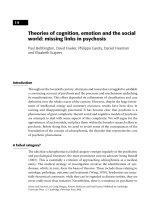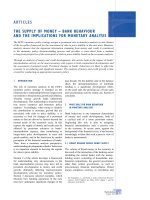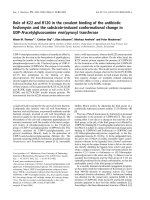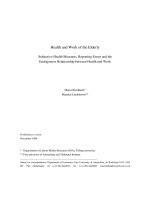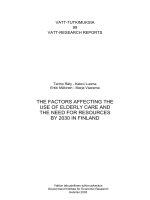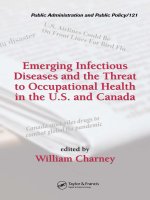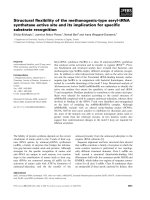Evaluation of water quality status of wetlands and the implication for ecological health in case of wonchi district , oromia region, ethiopia
Bạn đang xem bản rút gọn của tài liệu. Xem và tải ngay bản đầy đủ của tài liệu tại đây (2.51 MB, 106 trang )
Evaluation of water quality Status of wetlands and the
implication for Ecological health in case of Wonchi district ,
Oromia Region, Ethiopia
Balew Yibel Zeleke
Advisors: Dr. BikilaWarkineh
Dr. Seyeum Leta
A Thesis submitted to
The Department of Environmental Science
Presented in partial fulfillment of the Requirements for the Degree of Master of Science
(Environmental Science)
Addis Ababa University
ADDIS ABABA, ETHIOPIA
JUNE, 2017
0
ADDIS ABABA UNIVERISTY
GRADUATE PROGRAMMES
This is to certify that the Thesis prepared by Balew Yibel Zeleke, entitled: Evaluation of water
quality Status of wetlands and the implication for Ecological health in case of Wonchi
district , Oromia Region, Ethiopia and Submitted in Partial Fulfillment of the Requirements
for the Degree of Master of Science (Environmental Science) complies with the regulations of
the University and meets the accepted standards with respect to originality and quality.
Signed by Examining Board:
Name
Signature
Date
1. _________________ (Examiner) ______________________
_________________
2. _________________ (Examiner) ______________________
_________________
3. _________________ (Advisor) ________________________
_________________
4.
________________ (Advisor ) ________________________
_________________
5. ________________ (Chairman)________________________
_________________
i
ACRONYMS AND ABBREVIATIONS
AWD
APHA
BWR
BOD
BCWQI
CAPSNAC
Acute Watery Diarrhea
American Public Health Association
Basic water requirement
Biochemical Oxygen Demand
British Columbia Water Quality Index
Capacity Building for Sustainable Natural Resource Management
and Agricultural Productivity under Changing Climate
CCME
Chl-a
COD
E.C
DO
FDRE
FAO
FWQI
GWP
ICWE
IJAC
IRC
MEA
NSFQI
OWQI
PCA
RDA
Sal.
SD
SRP
TSS
TDS
TP
TN
Turb.
WHO
WQ
WQI
WWAO
Canadian Council of Ministers of the Environment
Chlorophyll-a
Chemical Oxygen Demand
Electro conductivity
Dissolved oxygen
Federal Democratic Republic of Ethiopia
Food for Agricultural Organization
Florida Stream Water Quality Index
Global Water Partnership
International Conference on Water and the Environment
International Journal of Advances in Chemistry
International Water and Sanitation Centre
Millennium Ecosystem Assessment
National Sanitation Foundation of quality Index
Oregon Water Quality Index
Principal Component Analysis
Redundancy Analysis
Salinity
Standard deviation
Soluble reactive phosphorus
Total suspended solid
Total dissolved solid
Total phosphorus
Total Nitrogen
Turbidity
World Health organization
Water Quality
Water Quality Index
Wonchi Woreda Agriculture Office
ii
ABSTRACT
Evaluation of water quality Status of wetlands and the implication for
Ecological health in case of Wonchi district , Oromia Region, Ethiopia
Balew Yibel Zeleke, MSc Thesis
Addis Ababa University, 2017
In Wonchi district, there are eight wetlands, which include lake, marshes and swamps.
These Wetlands play great role in providing holistic ecological services for the district,
conserving and protecting plants and animal life. Recently, these wetlands are highly
threaten with anthropogenic activities like overgrazing, cultivation, rim disturbance
through infrastructure construction, deforestation, settlements in and near wetlands.
However, there is no sufficient information that shows water quality status of wetlands.
Hence, this study aimed to assess the water quality of the wetlands and their ecological
implications. A total of 126 water samples were collected from eight wetlands from
October2016 to May 2017. Water samples for physicochemical, microbial, biological
and heavy metals analysis were collected using polyethylene bottles. The samples were
analysed in the laboratory according to standard methods for water and wastewater
analysis. Data Analysis was performed by descriptive statistics, one-way Analysis of
Variance (ANOVA), and Multivariate analysis using SPSS IBM 20 and CANOCO for
windows 4.5 version soft ware. The overall water quality parameters analysis results
have been as ranged pH(6.7-8.6), E.C(123-1978) ,Temperature(7.9-29.3 ), Turbidity(0.51124 NTU), DO(2.7-12mg/l) BOD(0.1-5.04), COD (2.5-142),No3-N (0.02-11.9), No2-N
(0.002-0.3), SRP(0.01-3.5mg/l), TN(2-54), F-(0.16-3.2), TP(0.05-3.9),TH(22-238),
Chloride(14-84.3), TSS(0-4.5mg/l), Fe(0.01-4.6)T.F(0-1165), F.C(0-930). The water
quality indices of the wetlands were computed and values ranged from 164 to 640. These
results revealed the wetlands water quality status were not good for public health and
drinking purpose. Nutrient loads and over utilization of the resources in the district were
the most significant factors that may have led to the reduction of water quality problem.
The result of this research can be used for different purposes including assessment of
water quality in aquatic ecosystems for the ambient water quality targets in SDGs.
Keywords : Wonchi district Wetlands, Physicochemical & Biological parameters, multivariate analysis,
WQI
iii
ACKNOWLEDGEMENT
I am heartily thank my Almighty God for his willingness to start and end this work with
power. It is my in depth pleasure to provide deepest appreciation to my advisor Dr.Bikila
Warkineh for his wholehearted consistent guidance, finical support, enthusiastic advice,
fast and urgent communication, important document and reference sharing, valuable
correction and commenting the thesis throughout the study period, while provided me all
the required inputs to accomplish this paper without his help this was not finalized. I also
thank my co-advisor Dr. Seyeum Leta for his help and intensive advise the paper got
compiled. I am deeply grateful to Ministry of Water, Irrigation and Electricity laboratory
staff members, Addis Ababa University (the center of Environmental Sciences and
Limnology lab ) for their limitless support during laboratory work. I also greatly
appreciate my friends Eskezi Alemayehu, Getu, Kasahun, Mesifin, Tarekegn, Temesigan,
and Mingizam for their kind support in the water quality testing and analysis.
I thank CAPSNAC project that provided the financial support for this work.
Finally, I would like to express my lovely feeling to my wife, my kids, Father, Mother
Brothers, and Sisters for their unreserved collaboration, patience and every day thought
about my movement and work effectiveness to end this first challenge line for my future
carriers.
iv
CONTENTS
ACRONYMS AND ABBREVIATIONS ......................................................................... ii
Abstract .............................................................................................................................. iii
Acknowledgement ............................................................................................................. iv
List of Tables .................................................................................................................... vii
List of Figures .................................................................................................................. viii
List of Appendices ............................................................................................................. ix
1. Introduction ..................................................................................................................... 1
1.1. Background .............................................................................................................. 1
1.2. Statement of the Problem ......................................................................................... 6
1.3. Objectives ................................................................................................................. 8
1.3.1. General Objectives ............................................................................................ 8
1.3.2. Specific Objectives ............................................................................................ 8
2. Literature Review............................................................................................................ 9
2.1. Distribution, Status and Importance of wetlands in ethiopia ................................... 9
2.1.1.Defintion of Wetlands ........................................................................................ 9
2.1.2. Wetlands in Ethiopia ....................................................................................... 10
2.1.3. Types of Wetland in Ethiopia .......................................................................... 11
2.2. Importance of Water Quality.................................................................................. 14
2.3. Estimation of Water Quality Index (WQI) ............................................................. 20
3.Significance of the study ................................................................................................ 24
4. Scope and limitation of the study.................................................................................. 24
5. Materials and Methods .................................................................................................. 25
5.1. Study area Discripttion ........................................................................................... 25
v
5.2. Climate ................................................................................................................... 27
5.2. Study design and Sampling Sites ........................................................................... 29
5.3. Water Sample Collection and Preservation ............................................................ 29
5.4. Analysis of Physicochemical and Biological parameters ...................................... 30
5.4.1. Physicochemical parameters............................................................................ 30
5.4.2. Biological parameters ...................................................................................... 31
5.5. Development of Water Quality Index (WQI) .................................................... 34
5.5. Data Analysis ......................................................................................................... 36
4. Results ........................................................................................................................... 38
4.1. Physicochemical parameters of District wetlands .................................................. 38
4.2. Biological Parameters ............................................................................................ 48
4.3. Selection of important parameters.......................................................................... 51
4.5. Multivariate Water Quality Parameters Analysis .................................................. 53
4.5.1. Correlation Between Parameters ..................................................................... 53
4.5.2.Correlation between Phytoplankton Diversity and Environmental Parameters 55
4.5.3.Relationship between District Wetlands........................................................... 56
4.6.Water Quality Index ................................................................................................ 57
5.Discussion ...................................................................................................................... 61
5.1 Physicochemical Parametersof district Wetlands ................................................... 61
5.2. Biological Parameters of district wetlands ............................................................. 70
5.3. Water Quality Index (WQI) Implication ................................................................ 72
5.4. Ecologicalhealth Implication.................................................................................. 73
6. Conclusion and Recommendation ................................................................................ 76
7. References ..................................................................................................................... 79
vi
LIST OF TABLES
Table 1: Classification and ranges of variation of the WQI based on overall index score ............ 34
Table 2:Physicochemical and Bacteriological parameters of wetlands ( Mean±SD) . .................. 40
Table 3: Identified phytoplankton Taxa in Wonchi district wetlands and their abundanc ........... 50
Table 4 : Eigen-values with the nine principal parameters considered for selection ..................... 51
Table 5 : Comparison of selected water quality parameters' mean in the wetlands ...................... 52
Table 6: Values of Pearson Correlation Coefficient(r) for Various Parameters ............................ 54
Table 7 : Weight assigned to each parameters .............................................................................. 57
Table 8 : WQI results of Wetlands and their Water pollution Classes........................................... 58
Table 9 : WQI results of Sampling sites of Wetlands and their Water pollution Classes .............. 58
Table 10 :Comparison of the physicochemical parameters of Wonchi Wetland ........................... 68
Table 11 : Comparison of the physicochemical and biological parameters of Wetlands ............. 69
vii
LIST OF FIGURES
Figure 1 : A map of Study Area ..................................................................................................... 27
Figure 2 : Monthly Distribution Pattern of Rain fall and Temperature Variation ......................... 28
Figure 3 : Spatial Variations of physical parameters on Wetlands ................................................ 39
Figure 4: Physicochemical parameters (pH, E.C and TDS) variations among Wetlands .............. 39
Figure 5:a) Monthly trends of Fluoride on Wetlands B) Spatial variations on Wetlands .......... 41
Figure 6 : Nutrients load variations on Wonchi Wetland Sampling Sites ...................................... 42
Figure 7 : Nutrient load (Nitrogen Species) variations for Wetlands ........................................... 42
Figure 8 : Monthly trends of TN in the Wetlands .......................................................................... 43
Figure 9: Temporal variations of TN on Wonchi Wetlands ......................................................... 43
Figure 10: Temporal variations of NO3-N on Wonchi Wetlands ................................................. 44
Figure 11: Phosphorus Species variations on Wetlands ................................................................ 45
Figure 12 : Variations of Iron concentration in the Wetlands ........................................................ 45
Figure 13 : DO, BOD and COD Concentration in respective Sampling Sites ............................... 47
Figure 14 : A)Monthly trends of COD in the District Wetlands ................................................... 47
Figure 15 : Microbial load variations in the Wetlands.................................................................. 48
Figure 16 : Fecal Contamination level in the Wetlands ................................................................. 49
Figure 17: Phytoplankton Abundances in all over the Wetlands ................................................... 49
Figure 18 : Ordination diagram of Redundancy analysis ( RDA) ................................................. 55
Figure 19; Clustering of all over district wetlands using Ward's methods .................................... 56
Figure 20 : Changes of WQI on all over district Wetlands ............................................................ 59
Figure 21 : Changes of WQI on Wetlands Sampling sites ............................................................ 59
viii
LIST OF APPENDICES
Appendix 1: Sampling Sites of Wonchi District Wetlands .............................................. 85
Appendix 2 : Mean Values for measured Physicochemical and Bacteriologicalparameters
of wetlands ........................................................................................................................ 86
Appendix 3 : Mean Values for measured Physicochemical and Bacteriologicalparameters
of Wonchi Wetland Sampling Sites .................................................................................. 87
Appendix 4 : Mean, Maximum, Minimumand Standard deviationValues for measured
Physicochemical and Bacteriologicalparameters of wetlands .......................................... 88
Appendix 5: Wonchi Wetland WQI Calculation result ................................................... 89
Appendix 6: Haro Wetland WQI Calculation result ......................................................... 89
Appendix 7 : Harogaliye WQI Calculation and result ...................................................... 90
Appendix 8: Borifitu WQI Calculation result ................................................................... 90
Appendix 9 : Gagure Wetland WQI Calculation result .................................................... 91
Appendix 10 : Godawebe WQI Calculation and result .................................................... 91
Appendix 11 : Meti-Waliga WQI Calculation and result ................................................. 92
Appendix 12 : Waliga Wetland WQI Calculation and result ........................................... 92
Appendix 13 ; Images of some identified Phytoplankton taxon in the study area .......... 93
Appendix 14 : Field Observation and Practices in the study area .................................... 95
Appendix 15: Physicochemical and Biological Mean Values of sampling sites .............. 96
ix
CHAPTER ONE
1. INTRODUCTION
1.1. Background
Ethiopia is endowed with highly considerable water resources and wetland ecosystems
that include twelve river basins, eight major lakes, many swamps, floodplains and manmade reservoirs that store approximated 158 billion cubic meters surface and ground
water under different geological formations and climatic conditions (MoWIE, GTP1 final
report ). According to EFAP (1989), 110 billion cubic meters of water runs off annually
from the above sources. Major rivers and lake systems, together with their associated
wetlands, are fundamental and basic parts of life interwoven into the structure and
welfare of societies and natural ecosystems. Beyond these, Water is life and life on earth
is linked to water. Water is a key driver of economic and social development while it also
has a basic function in maintaining the integrity of the natural environment. However,
water is only one of a number of vital natural resources and it is imperative that water
issues are not considered in isolation. The various uses of water impinge upon its
availability in terms of quantity, quality and time for various economic, social and
environmental needs. The availability of water in large quantities has been considered an
essential part of civilization throughout the different periods of roman times and
others(WHO,1983).
Farming/agricultural practices and the development of settlements lead to the beginning
of the problem that faces mankind today. The importance of quality water bodies has
been established for years for different purpose particularly wetlands that are rich in
1
aquatic life composition and have variety services including ensuring ecological stability.
It is believed that wetlands are productive ecosystems that can play an important role for
socio-economic development if they are effectively utilized and conserved on a
sustainable basis.
Wetland can be defined in different ways from their functions and values point of views
from countries perspectives. Wetlands are defined as land covered by shallow water
encompassing lakes, rivers, swamps, floodplains, ponds, aquifers and dams. Thesis
covers the district „minor‟ wetlands and lake whose ecological and hydrological functions
are not often recognized as productive. These are mainly swamps, marshlands and
floodplains, which are being converted and altered at an alarming rate into what many
people consider better alternative uses.
Most of the time the term wetland is not clearly recognized because it expresses a narrow
range of properties and functions within wet area. In practical and reality, it is a
transitional zone that exhibit extremely different properties and functions that vary with
both space and time. Determining the relationship between wetland function and water
quality within the context of an ecological system or landscape requires understanding of
the range of chemical, physical and biological processes that are likely to occur.
While the degradation of water quality (WQ) is almost invariably the result of
anthropogenic activities, certain natural phenomena can result in WQ falling below the
standard required for particular purposes (World Meteorological Organization, 2013).
WQ is influenced by both non-point source pollution (from farming activities and the
surrounding catchment) and point-source pollution (from sewage treatment and industrial
2
discharge) as principal sources. For agriculture, the key pollutants are nutrients,
pesticides, sediment and faecal microbes. Oxygen consuming substances and hazardous
chemicals are more associated with point-source discharges. Spatial variation in WQ is
one of the main features of different types of water bodies and is largely determined by
the hydrodynamic characteristics of the water body.
According to (MEA, 2005) wetland ecosystems are degraded and being lost rapidly than
other ecosystems globally. Similarly Ethiopian wetlands are deteriorating alarmingly
across the country (Afework Hailu , 2007). Although , Ethiopia has diverse wetland
ecosystems across the country which includes swamps, marshy wetlands, flood plains,
natural and human-made lakes, peaty wetlands and swamp forest wetlands. These
wetlands are highly degraded by agricultural practices through sediment load, drained
and used for small scale irrigation but also as intensive a grazing land in dry season and
entrance of wet season (Leykun Abunje, 2007). The same time in many cases they serve
as source of drinking water and other domestic purpose for the local communities.
Wetland ecosystems provide unlimited ecosystem services throughout the world. These
include services such as water storage, ground water recharge, and flood control,
shoreline stabilization, and water quality control, moderation of climate, flood regulation
and hotspots for biodiversity (MEA, 2005). They provide these services when their
ecological characters are fully functional. Studies on ecological character of wetlands are
at best scanty but mostly lacking in Ethiopia. Studies on ecological character of wetlands
help us determine the health of wetlands ecosystems and their ability to deliver vital
services to the community. This study will have valuable advantages on studying wetland
3
ecosystems in a comprehensive manner in order to address key issues that affecting the
health of these ecosystems.
Now, there are a lot of chemical as well as biological mechanisms that are in placed in
the world to treat point and non point source pollutants /wastes that are discharged to the
environment. Among them, Wetlands are natural filters and environmentally friend, helping
to improve the quality of runoff water from urban and agricultural lands by trapping
pollutants. Wetlands are particularly useful because they are generally located between land
and open water. This allows them to intercept many pollutants before they enter to the river
and other water bodies system. Wetlands have long been employed for the treatment of pointsource wastewaters as well as non-point source pollution (Hammer, 1989). But the
management of wetland is very poor and their existence is in doubt in the world and losing
their ecological balance/services contribution. the same time unbalance of the wetlands
ecosystem is expected. Having the clear knowledge on their physicochemical and biological
character , the species that have socioeconomic advantages , might show/ indicate the
management aspect and increase community involvement.
In my study area the Wonchi district, there are eight wetlands including lake, marshes
and swamps. However these wetlands are being highly degraded because of overgrazing,
cultivation, rim disturbance through infrastructure construction, deforestation, settlements
in and near wetlands. The most well-known water body and relatively studied wetland in
the district is Wonchi Crater Lake ( Teressa, 2014,Fasil et al, 2014, Fasil Degefu &
Michael Schagerl, 2015). There is no recorded data that show the district wetlands are
polluted or not. In addition, due to the nature of soils in the district and severe
degradation of the natural vegetation because of community awareness, the water quality
of wetlands in the district are thought to be being degraded and polluted.
4
This paper mapped eight wetlands of the district ,identified and classified the wetlands
based on their nutrient load, microbial load and other anthropogenic effects using WQI
calculation. The wetlands in the district are humans as well as naturally influenced due to
high population density, knowledge gap and over-utilization of all natural resource types
in the district. Looking for the overall situations of wetlands water quality in the district
was demanding and helpful to clearly evaluate the wetland water quality status.
Water quality issue is very important factor to evaluate environmental changes which has
great link between economic and social development. Investigation of water quality
status for relatively less polluted area/wetland are being critical issues to set proper
management systems before losing them. However, Expressing water quality issue is not
as easy as expressing water quantity. Assessment of the quality is a complex process
undertaking multiple and wider parameters which have to show various loads and stress
on over water quality physical, chemical and biology characteristics. Understanding on
water quality status is highly imperative to the sustainability of ecosystems and upcoming
developmental movements.
In general, this study aimed to evaluate the Water quality status of the Wetlands and
their implication for ecological health in the district.
5
1.2. Statement of the Problem
Wetland ecosystem degradation is considered as devastating as complete wetland functional loss
since degraded wetlands could lose their ability to perform their valuable wetland
functions/services at large. At the same time loss of small wetlands would have great
environmental impacts on the area. Now, the problems intensity is in increasing rate from time to
time and caused lose of many marsh, swamp and lakes including harromia lake in Ethiopia.
However, the impacts of environmental changes on wetland ecosystems (from both natural and
human causes) are poorly understood due to our limited knowledge of wetland ecology services
with respective to their physicochemical, biological, hydrological and ecological characteristics.
The first step in interpret the complex ecological processes of wetlands system is to locate or map
these areas on the landscape (Whigham, 1999) which will have clear geographical information
and provide hint for investigation on problems.
Settlement, intensive agriculture, overgrazing and deforestation in close proximity to water
bodies at rural area are among the potential cause of changes in water quantity and quality
(Habibaw and Seyoum, 2012). Changes of water quality potentially influence values and
suitability's' of water bodies for targeted purpose.
Wetlands in the Wonchi district, has been playing major socioeconomic and environmental role
in different ways including keeping ecological balance. But unfortunately, they are being
degraded progressively due to different human activities and natural processes. As a result there
is a tremendous influence on the quantity and quality of the ground and surface water ,
biodiversity and environment. The water quality deterioration leads unpredictable problems to the
environment components including public health. Monitoring on water qualities of the districts'
water bodies has been not yet done at all level.
6
In order to develop viable wetland conservation and management plan in the area a great deal of
effort has to put in understanding on water quality status at desired scales.
There is poor understanding and attitudes on water quality problems consequence in the area that
could still lose of ecological and socio-economical service. << So that the main problem is
becoming understanding on the actual problems of the water chemical and biological character
and the problems status to change the community, the stakeholders and responsible bodies
attitude towards wetland sustainable management/conservation.>> However, wetlands' advantage
have been talked everywhere without showing quantifiable wetlands water quality status level,
ground water potential increments capacity and other local unreserved benefits. Thus, this study
intended to evaluate and reveal the district wetlands water quality status through assessing the
physicochemical and biological characteristics of wetlands using WQI development.
7
1.3. OBJECTIVES
1.3.1. General Objectives
The General objectives of this study is to evaluate the water quality status of the eight
wetlands as well as their ecological health implication in Wonchi District, South Shiwa
Zone, Oromia Region.
1.3.2. Specific Objectives
To characterize the physicochemical and biological quality of the waters collected
from the wetlands
To analyze the association level of physicochemical and biological quality of the
wetlands water
To compute water quality index of the wetlands water through combination of
bacteriological and physicochemical parameters
To identify major stressors of the wetlands and indicate magnitudes of ecological
health implication in the district.
8
CHAPTER TWO
2. LITERATURE REVIEW
2.1. DISTRIBUTION, STATUS AND IMPORTANCE OF WETLANDS IN ETHIOPIA
2.1.1.Defintion of Wetlands and their importance
Wetland can be defined as an ecosystem of which its formation process and
characteristics are determined by existence of water. Wetlands occur where the water
table is at or near the surface of the land, or where the land is covered by shallow water.
Ramsar uses a broad definition of wetlands, including lakes and rivers, swamps and
marshes, wet grasslands and peat lands, oases, estuaries, deltas and tidal flats, near-shore
marine areas, man groves and coral reefs, and human-made sites such as fish ponds, rice
paddies, reservoirs, and salt pans (Aaron Marti,2011)
Wetlands have significance importance at all level that have contact directly and
indirectly particularly for community they have tremendous advantage. Hailu (2003)
clearly noted , wetlands main uses are social/ceremonial reeds, medicinal plants,
thatching reeds used for housing construction and granary roofing, domestic water
supplies, dry season grazing land, water for livestock, temporary crop-guarding huts of
reeds, cultivation, and craft materials. Now, these services are comparatively missing.
However, Cheffe (Cyperus latifolius) was the dense reed vegetation used for roofing,
craft material, fodder for cattle, and as a marketable commodity in a range of ceremonies
and celebrations throughout the year (2008).
9
2.1.2. Wetlands in Ethiopia
Ethiopia has plenty of Water resources that it has been encountered as East Africa water
tower in the continent. Among this resources, Wetlands have a place to increase the
caring capacity of the water resources through their restoration and filtration functions.
The status of wetlands are not well studied and documented in Ethiopia. “while rates of
wetland loss are documented for the developed world, there is limited study of these
ecosystems in countries like Ethiopia. Wetland loss is evident wherever major
developments like dams, irrigation schemes, and conversion projects are present in the
developing world.” (Aaron Marti,2011). There is a need of efforts to assessing water
bodies qualities and quantities that will have multiple implications for its management.
On the same time, Ethiopian wetlands are not well investigated, and studied in usable
manner. However, some authors tried to investigate and show how much wetlands area
have coverage in the country, are playing significant role for community in particular and
for country at large. For instance, Tesfaye (1990) listed 58 major lakes and marshes in
Ethiopia (including Eritrea).Hillman (1993)also listed a total of 77 wetlands in Ethiopia
and Eritrea, together with locations and He estimated that Ethiopian wetlands covered an
area of 13,699 km or 1.14% of the country‟s land surface. Here , lake Wonchi is
recognized and included in the list but didn't investigate other wetlands in the district that
covers 2% of the district.
10
2.1.3. Types of Wetland in Ethiopia
At the macro level, wetlands may be classified according to biomes. At the local, and
more specific level, wetlands may be grouped according to their habitat type, physical
and biological characteristics.
Ethiopian wetlands are grouped in to four major categories by biome based on ecological
zones, hydrological functions, geomorphologic formations and climatic conditions
(Tilahun et al ., 1996) . These biomes are the Afro-tropical Highlands, the Somali Masai,
the Sudan-Guinea and the Sahelian Transition Zone groups. I am interested to provide
some notes on the first group which is clearly tell the study areas situations.
Group I – the Afro-tropical wetland system
The Afro-Tropical Highlands includes the Central, Western and Eastern Highlands of
Ethiopia that serve as the prime water catchments and sources of its major rivers and
basins. The average annual rainfall is more than 2,000 mm. Rains are bimodal, with the
long rains extending from June to September and short rains between February and May
(Tilahun et al, 1996). These areas include most of Ethiopia‟s alpine and fresh water
wetland ecosystems. The wetlands in this biome include Lakes Tana, Hayk, Ashange, and
Wonchi, in the Western Highlands, Gojjeb and Ghibe. Whereas Floodplains associated
with the biome‟s lakes and rivers are many and needs detail assessment across the
country. Among these the Fogera and Dembia on the shores of Lake Tana are
encountered in many literature.
Some of the important wetlands of the Central Highlands are Wonchi district wetlands
from Wonchi rim to Woliso plan line based wetlands following Waliga river in upper
Omo Gibe basin, the Borkena and Dillu swamps in the Upper Awash Basin, and the
11
Chomoga-Yeda floodplains around Debre Markos in Choka water shade. The numerous
alpine lakes of the Bale Mountains and the swamps of Arsi and Alemaya are important
wetlands in the Eastern Highlands. There might be others which need further
investigation.
In other perspectives wetlands are grouped into 30 categorized and nine man made ones
based on their habitat type and basic physical and biological characteristics Dugan(1990)
.using the Directory of African Wetlands as a basis, Ethiopian wetlands are classified into
ten major groups, lakes being included (Hughs and Hughs, 1992). This classification is
based mainly on rivers and lakes drainage systems. The classification is not complete and
will need revision. Because they are so numerous, not all Ethiopian wetlands are listed.
The classification scheme is, however, able to show the diversity of wetland types in the
country. It is not able to cope with the many different forms of wetland e.g. alkaline,
fresh or seasonal. It includes those wetlands previously excluded by Hughs and Hughs
(1992), but excludes tidal and coastal wetlands because Ethiopia has no access to the sea.
According to Afework Hailu (2007) Ethiopian wetlands are currently being lost or altered
their ecosystem functions and structures by unregulated over-utilization, water quality
deterioration through water diversion for agricultural intensification, urbanization and
settlement , pollution and other anthropogenic interventions. This is true in Wonchi
district that clearly show there is great human influences on diversified wetlands. Among
anthropogenic activities, There is structural modification and reduction in size on their
many parts, change of chemistry and biology of water bodies, loss of plenty services to
community and aquatic ecosystems and so on. There was no focus dealing on the
problems in the area/ Wonchi district wetlands, while Wonchi lake has relatively got
12
focus to show the magnitude of its socio economic importance, Zooplankton and
phytoplankton diversity composition as a base line and partial physicochemical
characters through some gentile men like Fasile Degefu.
The district is known by Wonchi creator lake that has growing tourism investment and
made one of vulnerable area for pollution and unwise use of resources because of
existence of growing intensive agricultural practices, settlement and tourist loge waste
generation and doubt of owner ship right for the lake and the rim ( Negassa, 2014).
Negassa Fufa ( 2014)also studied their nutrient level and expressed as the lake is at oliga
otrophic conditions with ammonium being the primary nitrogen form in the lake,
however, this is done nutrient level is increasing rate ( Degefu,2015).Increments of
population, expansion of farming lands, intensive practice of overgrazing , rim and
sloppy land disturbance and destruction, resulting land use land cover change and
deteriorating of wetlands water quality. However socioeconomic importance and ecotourism values were not investigated at local, regional as well as at national and
international level.
According to the study made by Fasil Degefu ( 2015 )which is entitled by "The
phytoplankton community of tropical high-mountain crater lake Wonchi, Ethiopia"
categorized the existing phytoplankton community in to 53taxaand lined in five
taxonomic divisions which include health risk responsible micro alga organisms . Detail
micro-cyist species identification was not investigated to define health implication.
Further his study revealed as Nutrient levels indicated oligotrophic conditions with
ammonium being the primary nitrogen form.
13
Studies conducted on challenges and prospects of Wonchi creator lake showed that there
is question of sustainable ecotourism development because of conflict of interest on the
ownership of the lake, illegal land marketing, lack of basic ecotourism facilities,
disempowerment of women, unfair benefit sharing, institutional challenges ,
environmental degradation and understanding of pollution status gap (Teressa Derera,
2015)Rather than Wonchi lake, other wetlands situation were not investigated and no
baseline information about their social, economical , environmental role and their values
to the community. All these challenges are the result of anthropogenic out puts which are
poorly managed at all level particularly at community level the owner of the resource.
Scientific findings was not organized and disseminated to the community and
governmental offices at desired and usable form to change awareness status at all level.
2.2. IMPORTANCE OF WATER QUALITY
Ethiopian water resource policy clearly recognizes water as an economic good that
requires proper protection, conservation and management. The strategy also indicates the
management and conservation activities lined at basin scale while the developmental
issues are completely owned by regional level. Beside this, Ethiopia clearly set on the
SDG , ambient water quality as one goal to achieve the three basic goals: end poverty
reduction, protect the planet and ensure prosperity for all.
Mean while, Ensuring the health of water bodies is essential for maintaining viable,
abundance and diverse communities of organisms in aquatic ecosystems. People have
specific water quality requirements for their drinking, recreation, irrigation and other
purposes, however the requirements are vary based on their usage. Deterioration of water
14
quality affect the availabilities of water for consumption human as well as ecosystems,
increase treatment cost, increase prevalence of disease and others. These aquatic
ecosystem changes could be linked with basic water quality parameters like nutrient load,
temperature changes, DO level fluctuation, E.C,PH and Sediment load, (WHO, 2003).
Human beings has been responsible for a number of drastic changes and events observed
in the terrestrial and aquatic environments. The major consequences of man‟s activities
on the environment are habitat degradation, water pollution, air pollution and the
resultant deterioration of the aquatic ecosystem. Different Anthropogenic activities are
the major Water pollution problem in our world Larry (2005). This water pollution occurs
when the pollutants/contaminants are discharged directly or indirectly into water body
without adequate treatment.
Water is a universal solvent that makes it more vulnerable to be polluted whatever
exposures upfront. According to WHO (1996) Water is generally considered polluted
when it gets changed either of in its quality or composition or impaired by anthropogenic
contaminants because of the problems come from anthropogenic activities or natural so
as to become less suitable for drinking, domestic, hydropower, irrigation, industrial,
wildlife, recreational and other functions for which it would have been otherwise suitable
in its natural or modified state (EPA 2007). on the same time(WHO, 1996) clearly put as
Water quality is a term used to defined the suitability of water to deliver various uses in
terms of chemical, biological , physical, and radioactive characters or processes. Water is
affected dominantly through anthropogenic activities and in some case natural processes.
In order to prevent and minimize the problems associated with water, there are national
15
